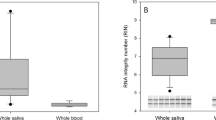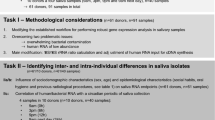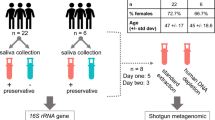Abstract
As an alternative to surgically obtaining samples (e.g., tail or tissue biopsy, toe dock, or blood sampling) from weanling mice to screen for transgene integration or other genetic monitoring procedures, we offer a simpler, nonsurgical method. A small amount of saliva, obtained from weanling mice by oral wash using a plastic pipet tip, contains enough oral epithelial cells and lymphocytes to yield sufficient DNA for nested primer polymerase chain reaction (PCR) analysis. The procedure can be repeated many times with minimal stress to the animal, in contrast to tissue biopsy procedures such as tail cutting. Sample analysis is rapid and straightforward; saliva is applied to sample collection paper and then purified using a solid phase DNA purification system. The paper, containing purified DNA, is added directly to PCR cocktail for the first round of amplification. For weanling mice, in the second round of amplification, a small amount of product from the first round is removed and added to PCR cocktail containing the second set of primers. With adult mice, an adequate volume of saliva may be obtained (dependent upon the sensitivity of the particular reaction) to eliminate the need for second-round amplification with nested primers. This technique is reliable, does not require organic solvents, and is more humane than protocols currently in use. Furthermore, this technique could replace hundreds of thousands of surgical biopsies on rodents annually, which are performed for both transgene determination and genetic monitoring procedures.
This is a preview of subscription content, access via your institution
Access options
Subscribe to this journal
Receive 12 print issues and online access
$209.00 per year
only $17.42 per issue
Buy this article
- Purchase on Springer Link
- Instant access to full article PDF
Prices may be subject to local taxes which are calculated during checkout
Similar content being viewed by others
References
Tinkle, B.T., Bieberich, C.J., and Jay, G. 1994. Molecular approaches involved in mammalian gene transfer: analysis of transgene integration, pp. 221–234 in Transgenic animal technology: a laboratory handbook. Pinkert, C.A. (ed.). Academic Press, San Diego, CA.
Pinkert, C.A., Irwin, M.H., and Moffatt, R.J. 1995. Transgenic animal modeling, pp. 901–906 in Encyclopedia of molecular biology. Meyers, R.A. (ed.). VCH Publishers, Inc., NY.
Pinkert, C.A. 1990. A rapid procedure to evaluate foreign DNA transfer into mammals. BioTechniques 9: 38–39.
Overbeek, P.A. 1994. DNA microinjection and transgenic animal production, pp. 69–114 in Transgenic animal technology: a laboratory handbook. Pinkert, C.A. (ed.). Academic Press, San Diego, CA.
Polites, H.G. and Pinkert, C.A. 1994. DNA microinjection and transgenic animal production, pp. 15–68 in Transgenic animal technology: a laboratory handbook. Pinkert, C.A. (ed.). Academic Press, San Diego, CA.
Hogan, B., Beddington, R., Costantini, F., and Lacy, E. 1994. Manipulating the mouse embryo: a laboratory manual. Cold Spring Harbor Laboratory Press, Cold Spring Harbor, NY.
Kooyman, D.L. and Pinkert, C.A. 1994. Transgenic mice expressing a chimaeric anti-E coli immunoglobulin α heavy chain gene. Transgenic Res. 3: 167–175.
Pinkert, C.A., Kooyman, D.L., and Irwin, M.H. 1995. Germline transmission of immunoglobulin transgenes conferring resistance to pathogenic Escherichia coli in mice. BARC XX Symposium, “Biotechnology's Role in the Genetic Improvement of Farm Animals”, Abstr., p. 43.
Mullis, K.B. and Faloona, F.A. 1987. Specific synthesis of DNA in vitro via a polymerase-catalyzed chain reaction. Methods Enzymol. 155: 335–350.
Schrewe, H. et al. 1990. Cloning of the complete gene for carcinoembryonic antigen: analysis of its promoter indicates a region conveying cell type-specific expression. Mol. Cell. Biol. 10: 2738–2748.
Kelly, C.L. et al. 1995. Functional correction of short-chain acyl-CoA dehydrogenase deficiency in transgenic mice. Am. J. Human Genet. 57: A52.
Kloosterman, A.D., Budowle, B., and Daselaar, P. 1993. PCR-amplification and detection of the human D1S80 VNTR locus. Amplification conditions, population genetics and application in forensic analysis. Int. J. Leg. Med. 105: 257–264.
Hopkins, B., Williams, N.J., Webb, M.B., Debenham, P.G., and Jeffreys, A.J. 1994. The use of minisatellite variant repeat-polymerase chain reaction (MVR-PCR) to determine the source of saliva on a used postage stamp. J. Forensic Sci. 39: 526–531.
Hochmeister, M.N., Budowle, B., Jung, J., Borer, U.V., Comey, C.T., and Dirnhofer, R. 1991. PCR-based typing of DNA extracted from cigarette butts. Int. J. Leg. Med. 104: 229–233.
Walsh, P.S., Metzger, D.A., and Higuchi, R. 1991. Chelex® 100 as a medium for simple extraction of DNA for PCR-based typing from forensic material. BioTechniques 10: 506–513.
Taniguchi, S., Maekawa, N., Yashiro, N., and Hamada, T. 1993. Detection of human T-cell lymphotropic virus type-1 proviral DNA in the saliva of an adult T-cell leukaemia/lymphoma patient using the polymerase chain reaction. Brit. J. Dermatology 129: 637–641.
Author information
Authors and Affiliations
Rights and permissions
About this article
Cite this article
Irwin, M., Moffatt, R. & Pinkert, C. Identification of transgenic mice by PCR analysis of saliva. Nat Biotechnol 14, 1146–1148 (1996). https://doi.org/10.1038/nbt0996-1146
Received:
Accepted:
Issue Date:
DOI: https://doi.org/10.1038/nbt0996-1146



